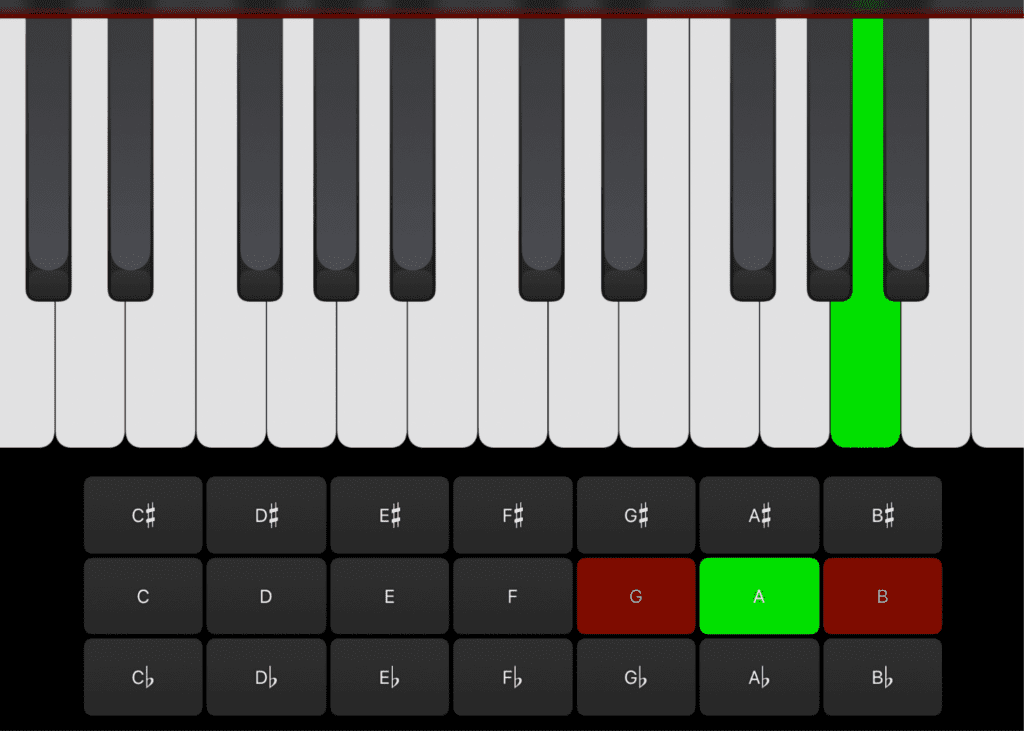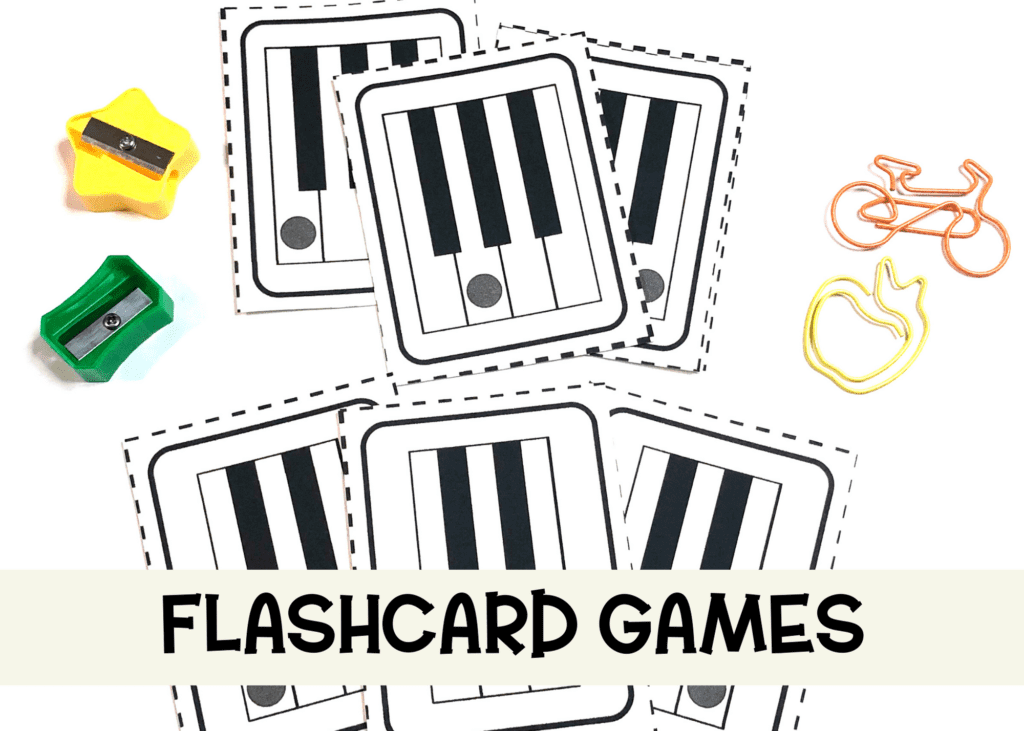This post may contain affiliate links. You pay the same, and I get a small commission for coffee. Yay! (Please see my full disclosure for further information.)
5 Best Ways to Teach Piano Key Names to Beginner Students
As a piano teacher, you know one of the first steps in piano lessons is to teach your students the names of the keys on the piano. But let’s be honest; it can be a bit dry and repetitive.
That’s why I want to share the five best ways to teach piano key names to beginner students beyond just reciting them repeatedly. The five best ways to teach piano key names are using apps, off-the-bench piano games, flashcard games, games on the piano, and improvisation/composition.

Ways to teach piano key names to beginner students
Here are the five best ways to teach piano key names to beginner students:
- Apps
- Off-the-bench Games
- Flashcard Games
- Games on the piano
- Improvisation and Composition Activities

1. Using Apps to Teach the Piano Key Names
One of my favorite ways to teach piano key names to students is by using apps. So many fantastic apps are available nowadays that are engaging and effective. Some apps use games and quizzes to help students learn the names of the keys, while others use visual aids like keyboard diagrams and interactive animations.
They gamify the learning experience by trying to beat a level or name the keys by a specific time to see if the student can do it faster in the next lesson. I’ve found that using apps in lessons makes learning more enjoyable and allows students to practice at their own pace and outside of lesson time.

Tenuto is a powerful studio app that can also quiz notes on the staff, intervals, key signatures, chords, and more!
How to Use:
- It has a section titled Keyboard Identification.
- In that section, there is a quiz game titled Keyboard Note Identification.

For the Keyboard Note Identification quiz game:
- you can set the game to how many piano keys you would like to quiz the student on (including sharp and flat keys)
- how many questions to ask the student
- and if the student should answer using letters or solfege.
Usually, my students play this game while I sort through their assignment binder in the lesson’s first 1-2 minutes. Students always ask to play this game even after learning the piano key names securely!

2. Using Off-the-bench Piano Games for Teaching Piano keys
Another fun way I like to teach piano key names to my beginner students is by using off-the-bench games. These games involve physical activities away from the piano, reinforcing the location and the piano key names.
Off-the-Bench Game: Musical Chairs
- scatter piano key cards on the floor
- students walk around the cards while music plays
- when the music stops, they must find and step on the piano key card corresponding to the letter I call out
It’s a fun way to get students moving and thinking, and it helps solidify their understanding of the piano key names.
You can get your free printable pdf piano key flashcards here. This set also comes with two bonus sets! The other two sets are note names on the staff and the musical alphabet letters (great for the memory match game!).
Looking for more Off-the-Bench Games? Check out this blog post!

3. Flashcard Games for Teaching Piano Key Names
When teaching piano key names to beginner students, flashcards can be a handy tool in your teaching arsenal. They are easy to make and can also be customized to suit your student’s needs.
Here are your free piano key flashcards to play these games.
Flashcard Game:
Memory Match
- students match the alphabet piano key name with its corresponding picture of the correct piano key

I find these games make learning more engaging and help students develop their memory and recognition skills.
Go Fish
- your student draws a card and asks you (or another student) if they have a matching card. For example, if your student draws a card with the letter name “C,” they would ask you if you have a “C” piano key card.
- If you have a matching piano key card, hand it over, and the student places the pair on the table.
- The game continues until the players have matched all the cards.

4. Using On the Piano Games for Teaching Piano Keys
Another way to make piano lessons fun yet effective is by incorporating games on the piano keys. Piano games can involve different approaches, such as having students identify specific keys, find, and then play them, or fun timed games to teach them to find the key quickly.
One the Piano Game: This is an easy way to test your student’s knowledge of piano keys right before a lesson that requires no prep or materials on your part!
Here’s how to play:
- call out a piano key name for the student to find
- the student uses the piano keyboard to find the answer
Yes, it’s just that simple!
This game can begin untimed in the beginning as the student learns the piano key names, and then as the student gets more comfortable with the piano keys you can time the student to find out how many piano key names the student can find in a minute!
Using digital timers can make the game even more fun!

5. Using Improvisation or Composition to Teach Piano Key Names
We talked about flashcard games, but flashcards can also be used for improvisation and composition exercises to learn the piano key names too! Allowing your students to experiment and improvise on the piano can help them explore the keys and develop a deeper understanding of how they relate.
Composition Game:
- Students place the piano key flashcards on the piano making up their own melody. You can limit the number of cards, so the melody won’t get too long. Let’s say five piano key cards.
- The student must play the five piano key names on the five cards from their melody.
- You prompt the student to name the cards by asking what the last piano key of the melody was. Or what is the third piano key in the melody? The student can answer the questions by naming the piano key.
Improvisation Game:
- you name a piano key and have the student find the key on the piano.
- Ask the student to make up a melody using only the three notes above it.
- Have the student name those three notes.
- Give the student a descriptive word for their melody, such as gentle, mad, happy, etc.
- Let the student improvise!
- Ask the student what piano key name did they end on?
Don’t forget you free pdf printable flashcards!
In conclusion, teaching piano key names to beginner students doesn’t have to be boring or repetitive. As a piano teacher, it is essential to use fun and engaging methods to teach students, which will help them retain information better and be more motivated to learn.

The five best ways to teach piano key names to beginner students include using apps, off-the-bench piano games, flashcard games, on-piano games, and improvisation/composition. By trying these ways, you can make learning piano key names an exciting and enjoyable experience for your students.
